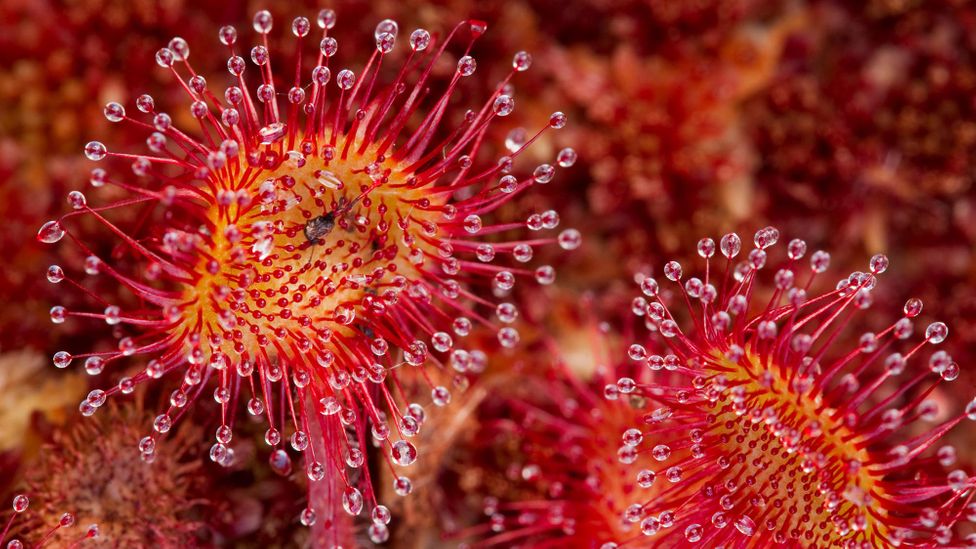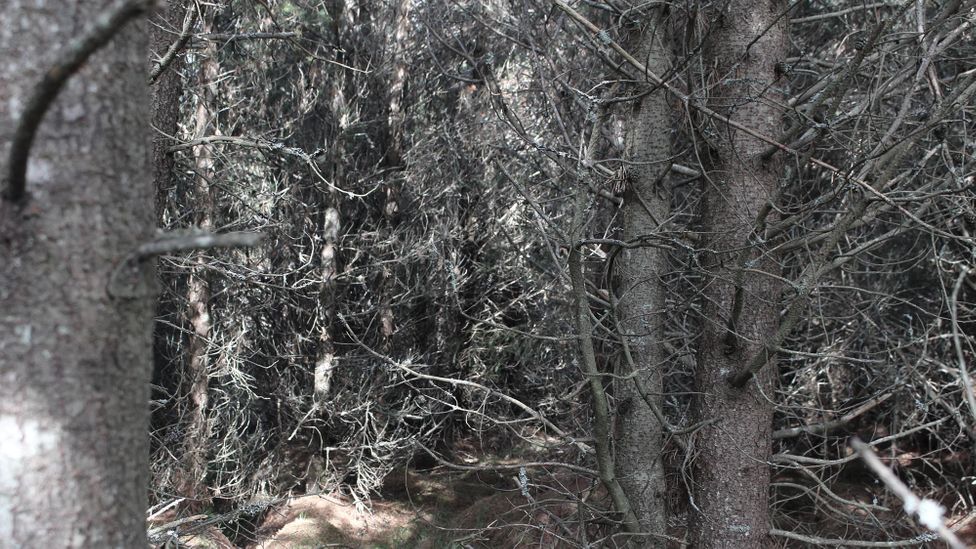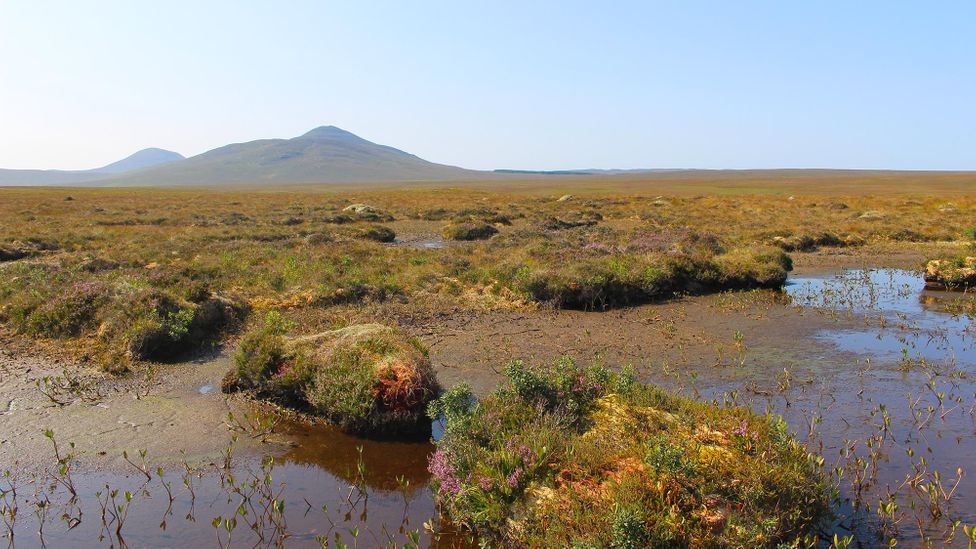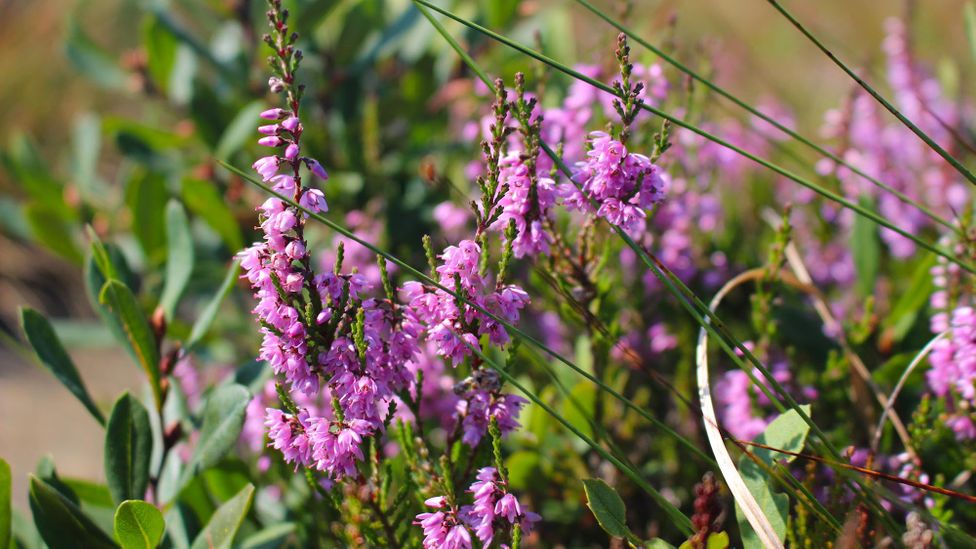The promise and danger of Scotland’s bog
Scotland #Scotland

The ancient blanket bog of northern Scotland is reaching a turning point in its long history – degrade or flourish. Which way it goes will have significant consequences for climate change.
A
As I watch the predator, its flaming orange-red tendril outstretched, it makes a catch. Its prey writhes, working itself deeper into a smothering grip. The flagrant sunset-coloured carnivore has made little effort to conceal itself, but its prey was unable to resist the allure of its sticky trap.
Crouching on a boardwalk suspended over an ancient peatland, I’ve just watched a round-leafed sundew plant ensnare a Scottish midge – one tiny instance of the bog acquiring the resources necessary to sustain the otherworldly landscape of Flow Country, in Caithness and Sutherland in the north of Scotland.
The vibrant sundew, which measures only an inch or so across, is surrounded by the more sober greens and earthy reds of sphagnum mosses. Though less flashy, sphagnum is arguably far more remarkable than the carnivorous sundew. It’s a plant that seems to carry its habitat with it, able to hold 20 times its weight in water and containing less solids than milk. If you pick up a living strand of sphagnum, one end looks much like the other because it has no roots. Each wet green frond sits in the middle of a chaos of other fronds, all saturated in water and perched on top of their predecessors.
Sphagnum is the plant largely responsible for creating the unique habitat of the Flow Country. It has grown here for 10,000 years or more, since the onset of a cool, wet climate in northern Scotland at the end of the Pleistocene era. As countless generations of sphagnum have germinated, died and been buried, these mosses have formed a bog that has locked in 400 million tonnes of carbon – more than three times the amount stored in all of Britain’s woodlands.
“The bog plants function very much like a forest – they photosynthesise and create biomass. Moss and trees are not very much different in that respect,” says Roxane Andersen, professor of peatland science at the University of the Highlands and Islands in northern Scotland. But, compared with forests, there is a crucial difference in a healthy bog. “The conditions in the bog aren’t very good for decomposition, so the carbon makes its way from biomass to peat.”
The bog’s 10,000-or-so year history is coming to an abrupt turning point. With climate change escalating, warmer summers and frequent droughts risk drying the bogs out, releasing their carbon. The risk is that bog degradation becomes a runaway train. “Peatlands that are already degraded are likely to degrade further,” says Andersen. “Drought and wildfires are more likely to affect peatlands that are not in good condition.”
There are, however, ways to make the bog more resilient and restore it to good health. With these interventions, alongside a rapid reduction in global carbon emissions, it’s hoped the bog could continue to absorb carbon and support a thriving rare ecosystem for many more years. Otherwise, Scotland’s bogs – which hold the equivalent of around 140 years of the nation’s greenhouse gases – could release their stores.
“The bogs can be our best ally or one of our worst enemies,” says Andersen.

The peat bogs of Flow Country are full of unusual plants specialised to the region’s cool, wet conditions (Credit: Alamy)
Historically, Scotland’s bogs have had a bad name. For centuries, they have been misunderstood to be wastelands that would do better as cultivated agricultural land. While attitudes are slowly changing, popular views of the bogs remain mixed at best.
The global peat crisis
Scotland’s bogs make up just a fraction of the world’s peatlands. Globally, peatlands store twice as much carbon as all the world’s forests.
“The global peatland system should be a strong net sink, but because of the large fraction that is degraded, it is not,” says Roxane Andersen, professor of peatland science at the University of the Highlands and Islands in northern Scotland. “The rate at which carbon is coming out of those degraded peatlands is far higher than the rate at which it’s going in.”
Like Scotland’s bogs, many tropical bogs are vulnerable. In Indonesia, the vast majority of its extensive peatlands have been severely degraded to fuel the world’s demand for oil palm. The largest peatland in the tropics, the Cuvette Centrale in the Congo Basin, is now at risk after several large tracts were auctioned for oil exploitation.
Globally, degraded peat bogs release the equivalent of 2.6-3.8% of greenhouse gases from human activity every year – more than from aviation.
This view of the bog as wasteland has been behind many of the rapid changes that led to its degradation. After World War Two, a drive to make this apparently useless land productive for agriculture and forestry encouraged draining of the bogs. The damage was done quickly: cut a drain in the sodden mass of a bog and the water will drain out of its upper layers. Trees can then put down roots in these soils, further lowering the water table.
In the 1970s and 1980s, further incentives made afforestation appealing to landowners, including in the far north of Scotland despite fierce opposition from conservationists. As drainage and forests dried out the upper layers of peat, the carbon that had been sequestered there for millennia began to be released.
This isn’t the only way we have intervened in Scotland’s peatlands. In an area with historically few trees, for centuries the bog was cut to burn as fuel for warmth across the Highlands and Scottish islands. It has also been drained to grow crops, graze animals and build on.
All in all, 80% of the UK’s peatlands are degraded and in deteriorating condition due to plantations, draining for agricultural use and other human uses. A dry, degraded bog is more prone to wildfires, which have become frequent events in the Flow Country. In 2019, a single peatland fire doubled Scotland’s carbon emissions for the six days that it burnt.
Restoring the bog
Andersen, who has worked on the Flow Country since 2009 and lived there since 2012, tells me that the reason peat bogs are such a good store of carbon comes down to their wetness. Stagnant water helps form a protective layer from the atmosphere above and in particular from oxygen, which fuels the chemical and microbial breakdown of the buried organic matter. The challenge, therefore, is to keep the bogs from drying out at all costs and to rewet them in places where they have already been damaged.

Monoculture plantations in Flow Country drain the bog of water and kickstart the process of degradation and greenhouse gas release (Credit: Martha Henriques)
The UK is unusually rich in blanket bog – large, continuous stretches of upland peat fed by rainfall. Around 13% of the world’s blanket bog can be found in the UK, with the bulk of that share found in Scotland. Overall, peatlands cover 20% of Scotland’s landscape, and are thought to hold more than half of the country’s carbon in soils. After almost 10 years of concerted action to protect its peatlands, Scotland is being recognised as a leader in peat restoration.
One of the Flow Country’s pioneering restoration projects is at Forsinard Flows, where the nature conservation charity the Royal Society for the Protection of Birds (RSPB) has been removing plantations of non-native conifers. Ben Oliver Jones, site manager at RSBP Forsinard Flows, shows me what the organisation has been doing since it bought the land for restoration in 1995. We drive along a dirt track to an unremarkable-looking stand of conifers.
Inside one of the remaining old plantations, it’s easy to see that they have become a biodiversity desert. As I step into the forest, twigs snap loudly. The trees are planted so closely the sunlight is a dim greyish tinge, and the plantation floor is littered knee-high with bone-dry, brittle debris. It is eerily quiet and stuffy – I can hear no animals, and see few other trees, shrubs or fungi anywhere on the forest floor. “This is a monoculture,” says Jones. “It’s rare to see many birds in here.”
These plantations, though dense, aren’t productive. The nutrient-poor peat soil isn’t conducive to healthy tree growth, and the trees that do grow are of a quality too poor for construction or furniture.
Emerging from the gloomy interior of the plantation back out into the sunlight, I cross to the other side of the dirt track. Traipsing across the rough terrain, there are the remains of furrows where rows of trees have been cut down and removed. Their quality is so poor they can often only be used for cheap pulp or biomass, says Jones. In some places, the remaining stumps have been mulched and the chips scattered over the bog to rot down.
The soil does appear to be a little wetter already – picking off the top layer of debris, there is dark, damp soil an inch or so below the surface. Removing the trees and blocking drains has raised the water table, but there’s a long way to go before the bog reaches its pre-forested, carbon-sequestering state. That said, on the way back to the track my rubber boot becomes stuck in thick, viscous black mud for one alarming moment – a good sign for the water table perhaps, but less so for my socks.
Managing to keep my boots, we go a little further down the track to see where the land is a few years further on in its restoration. Here, there is more sign of typical bog vegetation reappearing – including the crucial sphagnum mosses. The land here is replete with little pools and brimming with insects, and Jones points out that these are also providing a habitat for birds such as the dunlin and greenshank. In more remote spots, species rare in the UK have been spotted, such as the common scoter.
“Some species return quickly to restoration sites,” says Jones. “Golden plover and lapwing are two birds species that have set up breeding territories on sites within two years of carrying out restoration work.”
The end result may be worth it, but the work at Forsinard Flows shows that it takes decades to reverse the damage done in the short time it takes to cut a few ditches and plant a grid of saplings.

A bog in good condition is a reliable sink of carbon, sequestering carbon for as long as the bog remains healthy and wet (Credit: Martha Henriques)
There are other ways to help heal the bog after human intervention. Compacted peat and vegetation can be used to repair bogs after they have been used for peat extraction. Hand-built dams help to slow down water flow and steeper slopes can be pinned with coconut mesh to stabilise them. So far, since the Scottish Government laid out its first national plan for peat, an estimated 19,000 hectares (73 square miles) has been restored – an area about the size of the city Aberdeen.
Carbon Count
The emissions from travel it took to report this story were 80kg CO2, travelling by train and car. The digital emissions from this story are an estimated 1.2g to 3.6g CO2 per page view. Find out more about how we calculated this figure here.
There are plans to scale up these activities with a carbon market scheme developed by the UK’s National Environmental Research Council and the International Union for the Conservation of Nature. Landowners can sell the carbon saved by restoration as carbon offsets – with the current projects lined up under the scheme across the UK, this could amount to the equivalent of an estimated 570,000 tonnes of CO2, or 230,000 personal flights from London to Sydney. (Read about the promise and pitfalls of offsetting and carbon markets elsewhere on Future Planet.)
The flow of greenhouse gases into and out of the bog is, however, remarkably complex. As well as the climate and water levels, factors like the plant species present and the precise lay of the ridges and furrows of the land can have a significant influence on the flow of gases in and out of the bog.
What’s more, bog restoration isn’t a zero-sum game: drying out a bog releases carbon dioxide (CO2) emissions, but rewetting one can cause a second surge in emissions – this time of methane, a greenhouse gas 84 times more potent than CO2 over a 20-year period, but shorter-lived than CO2 in the atmosphere.
“That’s the downfall of rewetting,” says Coleen Murty, a research assistant at Newcastle University who completed her PhD on carbon cycling in peatlands. “Obviously researchers have found that rewetting is really helpful for reducing CO2 emissions, so it’s all about understanding the trade-offs.”
At the moment, there’s little that can be done to prevent this post-rewetting surge. But Murty hopes that one day it might be possible to enhance our current techniques with a class of compounds that sphagnum moss naturally releases into its watery surroundings. These are phenolics, which are thought to act as antioxidants – compounds that absorb harmful “free radicals” that cause oxidation. “Antioxidants are really important, not just for peat but for humans as well,” says Murty.
The sphagnum moss secretes phenolics through pores in its cell walls, which the compounds help to stabilise. The phenolics are also anti-microbial, helping prevent microbes from breaking down the plant – and they are thought to chemically suppress methane generation in deeper layers of peat. However, when you dry peat and kill the sphagnum, it no longer releases phenolics. “The sphagnum tissue dries out and starts to crumble away” and the methane-suppressing phenolics are lost, says Murty. When the bog is rewetted in the absence of such compounds, methane produced in the oxygen-poor deep peat can bubble to the surface.
In the lab, Murty’s and her colleagues’ work has shown promising hints that adding phenolics to deep peat may provide a source of antioxidants thought to suppress methane generation. But, she notes, it is a long way from lab studies to the complex reality of the bog. “There’s not many field studies in these things yet, so it would be great to do those,” says Murty. “It’s pretty novel.”
One of the main challenges is from the sheer size of the bogs. “They cover really large areas in Scotland,” says Murty. “I think the limitations of doing chemistry research on restoration could be how would we implement this on a larger scale, and how much would it cost to alter the chemistry of the bog?”
(It’s worth noting that despite no solution yet to the methane surge after rewetting, promptly restoring degraded bogs leads to fewer greenhouse gas emissions in the long run than leaving them degraded – curbing the methane release would be an added bonus.)

Valuing the bog as a biodiverse and carbon-sequestering landscape could help protect more peatlands from degradation (Credit: Martha Henriques)
Tapping into the antioxidant profile of peat may be some way off, if it is practical at all, but there are other, more straightforward things we could be doing, says Andersen. First and foremost is preventing peatlands drying in the first place. “In terms of natural climate solutions, the best thing we can do is make sure as many peatlands as possible are no longer degraded,” she says. “We can avoid those emissions.”
Scotland’s wild heartland
Flow Country is one of the least-densely populated parts of Western Europe. It’s possible to walk for hours without seeing another soul, with just the wind to accompany you. But the occasional sight of ruined flagstone houses lying open and exposed are stark reminders of the past. A time when Flow Country wasn’t empty – far from it. (Read more about what it is like to visit the Flow Country on BBC Travel.)
Another is to challenge the idea at the root of much of the damage to the bog – that they are wastelands. Instead, they should be celebrated as a habitat as rare and precious as the world’s other highly biodiverse habitats, Andersen argues. “There are no peatlands that are World Heritage Sites in the world – to me that’s a really good example of just how undervalued peatlands are.”
Andersen has been working as part of the Flow Country Partnership, a consortium working to gain Unesco World Heritage status for the area. The UK government has approved the group’s plans to bid for the status from Unesco, and it is expected to put in its bid in 2023. “We have a climate and biodiversity emergency,” says Andersen. “Peatlands are full of highly specialised species – surely they should be part of what we want to preserve for future generations.”
For such a large component of the Scottish landscape, peatlands have been remarkably misunderstood for much of the time people have lived alongside them. Perhaps it’s time, as Andersen hopes, to see peatlands in a different light: a valuable carbon store, and a catalogue of history, archaeology, culture, rare ecosystems and biodiversity.
“They are not seen to be as charismatic as other ecosystems – the Great Barrier Reef or tropical rainforests,” Andersen says. “But if they were perceived as the important ecosystems they are, it might help us value them.”
If you turn your attention away from the bleak expanse of the landscape and focus instead on the tiny micro-worlds at the bog’s surface, this value is much easier to see. At a collection of ancient pools by a viewing platform at Forsinard Flows, a common hawker dragonfly darts over the black water, searching for a midge that hasn’t yet fallen prey to the bog’s more ferocious plants.
—
* Martha Henriques is Editor of BBC Future Planet, and tweets at @Martha_Rosamund
—
Join one million Future fans by liking us on Facebook, or follow us on Twitter or Instagram.
If you liked this story, sign up for the weekly bbc.com features newsletter, called “The Essential List” – a handpicked selection of stories from BBC Future, Culture, Worklife, Travel and Reel delivered to your inbox every Friday.